Learn how HRT can help prevent osteoporosis and reduce fracture risks for postmenopausal women.
Hormone Replacement Therapy (HRT) is a key treatment for managing menopausal symptoms and preventing bone loss. As estrogen levels drop after menopause, women face a significant risk of osteoporosis, leading to fractures.
HRT can help maintain bone mineral density (BMD) and reduce the risk of fractures, especially in the spine and hips. (1)
Key Takeaways
- HRT prevents bone loss by replenishing estrogen levels and maintaining bone mineral density, reducing fracture risk.
- Long-term use of HRT offers protection against osteoporosis-related fractures, especially in postmenopausal women.
- Health Canada regulates HRT to ensure safety, minimizing side effects while maximizing bone health benefits.
Understanding HRT and Osteoporosis Prevention
Hormone Replacement Therapy (HRT) is a treatment designed to help women manage the symptoms of menopause by replacing hormones that the body no longer produces. It’s not just for managing hot flashes or night sweats.
HRT plays an important role in preventing osteoporosis, a condition where bones become weak and brittle. Osteoporosis often hits women after menopause when estrogen levels drop, leading to a loss of bone density.
Key hormones in HRT, primarily estrogen and progestogen, have a direct effect on bone health. Estrogen, in particular, is crucial for maintaining bone mineral density (BMD). As estrogen levels decline during menopause, so does the body’s ability to retain bone mass, leading to osteoporosis. Adding estrogen back into the body through HRT can help slow or reverse this bone loss.
Progestogen, often combined with estrogen in women who still have a uterus, helps prevent the thickening of the endometrial lining, which can increase cancer risk. The combination of estrogen and progestogen in HRT not only helps manage menopausal symptoms but also reduces the risk of fractures by maintaining bone health.
How HRT Helps Prevent Bone Loss in Postmenopausal Women
Estrogen leaves a quiet but significant void after menopause. It isn’t just about hot flashes or mood swings—it’s about the bones. Without estrogen, calcium absorption plummets, leaving bones brittle and vulnerable to fractures.
HRT offers a lifeline. By restoring estrogen levels, it helps slow the breakdown of bone tissue (called bone resorption). Studies show that starting HRT within 10 years of menopause can boost bone density, especially in high-risk spots like the hips, spine, and wrists. (2)
Key benefits of HRT for bone health:
- Slows bone loss: Reduces the speed of calcium depletion.
- Strengthens weak bones: Improves density over time.
- Lowers fracture risk: Particularly in areas prone to osteoporosis.
While it’s not a one-size-fits-all remedy, HRT might be a game-changer for women prioritising bone health post-menopause. A chat with the doc can help tailor the right approach.
HRT and Long-Term Bone Health

The benefits of HRT on bone health aren’t just short-term. Long-term use of HRT has been shown to help maintain bone density and reduce the risk of fractures.
A woman who starts HRT early enough—ideally before the age of 60—can expect to see the greatest benefits. This early intervention can keep bones healthier for longer, decreasing the likelihood of painful and disabling fractures that might otherwise occur later in life.
In addition to reducing fracture risk, long-term HRT use helps prevent other complications related to osteoporosis, like spinal compression fractures, which can lead to a hunched back. When women start HRT during perimenopause or shortly after menopause, they have the best chance of avoiding these bone-related issues altogether.
But HRT is not a magic bullet. It’s only effective if taken consistently over the long term. That means once you start, you need to keep going for the best outcomes. Women who stop HRT too soon may find that bone loss picks up again, increasing their fracture risk.
Risks and Side Effects of HRT
Hormone replacement therapy (HRT) can feel like a lifeline during menopause, but it’s not without its downsides. Some women experience mild side effects—weight gain, mood swings, breast tenderness, or headaches. Annoying, yes, but these often fade as the body adjusts.
The bigger risks lie in long-term use:
- Cardiovascular concerns: Oral HRT might slightly raise the risk of heart attack or stroke, particularly for smokers or women over 60.
- Blood clots: Higher odds if there’s a high BMI or smoking history.
- Breast cancer: Mostly linked to combined HRT and extended use.
Despite these risks, the absolute numbers are small. For example, combined HRT may raise breast cancer risk by just 1 additional case per 1,000 women annually.
Health Canada tightly regulates HRT, ensuring safety standards are met. Women with concerns should weigh these factors with their doctor. It’s all about finding the balance that fits their health and goals.
Osteoporosis and Increased Fracture Risk in Menopausal Women
Postmenopausal women face an increased risk of fractures due to osteoporosis. The sudden drop in estrogen levels leads to rapid bone loss, which accelerates during the first few years after menopause. This means that fractures—especially in the spine, hips, and wrists—become more common.
HRT is often recommended as a preventive treatment because it reduces the loss of bone mineral density. By replacing estrogen, HRT can protect bones from breaking down, which lowers the risk of fractures. A key benefit of HRT is its ability to reduce the risk of vertebral (spine) fractures, which are common in older women and can be debilitating.
While HRT can’t reverse damage already done by osteoporosis, it can help prevent further bone loss and reduce fracture risk. It’s especially effective for women who are at a high risk of fractures due to factors like advanced age, low calcium intake, or a family history of osteoporosis.
The Role of Calcium and Vitamin D with HRT
Calcium and vitamin D are essential partners when it comes to bone health. While HRT helps by replenishing estrogen levels and reducing bone loss, calcium and vitamin D work alongside HRT to ensure bones remain strong and dense.
Calcium is the building block of bones, while vitamin D helps the body absorb calcium effectively. Without enough vitamin D, your body can’t absorb calcium properly, leading to weaker bones. The combination of HRT, calcium, and vitamin D has been shown to provide the most comprehensive protection against bone loss.
Health experts recommend that postmenopausal women take around 1,200 milligrams of calcium and 800-1,000 IU of vitamin D daily. These nutrients are found in dairy products, leafy greens, and fortified foods, but supplements are often necessary to meet daily requirements.
HRT Alternatives for Osteoporosis Prevention
Some women can’t—or won’t—choose hormone replacement therapy (HRT). For them, non-hormonal options to prevent bone loss are available. These treatments target bone resorption (the natural process of bone breakdown) and help reduce fracture risk.
- Bisphosphonates: Medications like alendronate and risedronate slow bone turnover, preserving density over time.
- Raloxifene: A selective estrogen receptor modulator (SERM) mimics estrogen’s bone-protecting effects—without the hormonal baggage.
- Denosumab: This injectable works by blocking RANKL, a protein that promotes bone resorption.
These treatments are highly effective but don’t address menopause symptoms like hot flashes. That’s a limitation. For women seeking a one-stop solution, HRT remains the gold standard—balancing bone protection and symptom relief.
Ultimately, every option has its strengths. Women should weigh these with their doctor, considering personal health and lifestyle. After all, the best treatment is one you can stick with.
How Health Canada Approves and Monitors HRT for Bone Health
Health Canada takes the regulation and approval of HRT seriously. All HRT products undergo rigorous testing to ensure they are both safe and effective. The approval process for HRT involves clinical trials that assess the impact on bone mineral density, fracture risk, and overall safety. This process ensures that only HRT products that meet stringent health standards are made available to the public.
Once HRT products are approved, Health Canada continues to monitor their safety. This includes reviewing new research and clinical data on the long-term effects of HRT and making adjustments to guidelines as necessary. Healthcare providers are encouraged to report any adverse effects of HRT, which helps Health Canada ensure the ongoing safety of these treatments.
Conclusion
Hormone Replacement Therapy remains one of the most effective ways to combat bone loss and prevent osteoporosis in postmenopausal women. For those who qualify, starting HRT early can have long-lasting benefits for bone health.
However, it’s crucial to weigh the potential risks and discuss all available options with a healthcare provider. If HRT isn’t the right choice, there are effective alternatives to consider. Through a combination of proper nutrition, supplements, and careful treatment choices, postmenopausal women can maintain strong bones and reduce the risk of debilitating fractures.
Want to learn more about your bone health options? Book a consultation with Modern Menopause today and get expert advice tailored to your needs. Book your appointment now.
FAQ
1. How does HRT help prevent osteoporosis during menopause?
Hormone Replacement Therapy (HRT) helps prevent osteoporosis by replenishing oestrogen levels, which naturally decline during menopause. Oestrogen is essential for maintaining bone density, and its reduction increases the risk of fractures.
By restoring oestrogen, HRT slows down bone loss, reduces fracture risks, and helps maintain overall bone health. This makes HRT particularly beneficial for women at risk of osteoporosis during and after menopause.
2. Is HRT the best treatment for osteoporosis prevention during menopause?
While HRT is effective for osteoporosis prevention due to its oestrogen-replenishing effects, it is not always the first choice for every woman.
Women with certain medical conditions or those at risk of cardiovascular issues may opt for non-hormonal treatments like bisphosphonates or selective estrogen receptor modulators (SERMs). The decision should be personalized, based on individual health factors and symptoms, in consultation with a healthcare provider.
3. What are the risks of using HRT for osteoporosis prevention?
HRT has some risks, particularly for women over 60 or those with a history of breast cancer, blood clots, or heart disease.
It can slightly increase the risk of breast cancer with prolonged use and may cause side effects like bloating or mood changes. However, when started early (before age 60) or within 10 years of menopause, the benefits, including osteoporosis prevention, generally outweigh the risks for most women.
4. Can vaginal estrogen be used for osteoporosis prevention?
Vaginal estrogen is primarily used to treat vaginal and urinary symptoms of menopause rather than osteoporosis.
While it provides localized relief and minimal systemic absorption, it does not offer the same bone-protective benefits as systemic forms of estrogen, such as those found in oral or transdermal HRT. Therefore, for osteoporosis prevention, systemic estrogen therapy is more effective.
5. What are alternative treatments for osteoporosis prevention if HRT is not suitable?
For women who cannot use HRT, alternative treatments for osteoporosis prevention include bisphosphonates (like alendronate), denosumab, and selective estrogen receptor modulators (SERMs).
Lifestyle changes, such as weight-bearing exercises, a calcium-rich diet, and vitamin D supplements, are also vital in maintaining bone health during menopause. A healthcare provider can help determine the best course of action based on individual risk factors.
References
- https://pmc.ncbi.nlm.nih.gov/articles/PMC10009319/
- https://www.sciencedirect.com/science/article/abs/pii/S037851229900064X

Leave a Reply